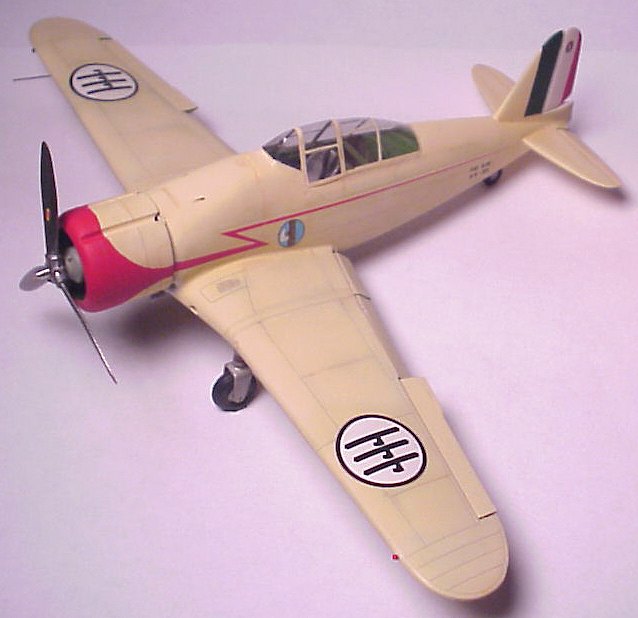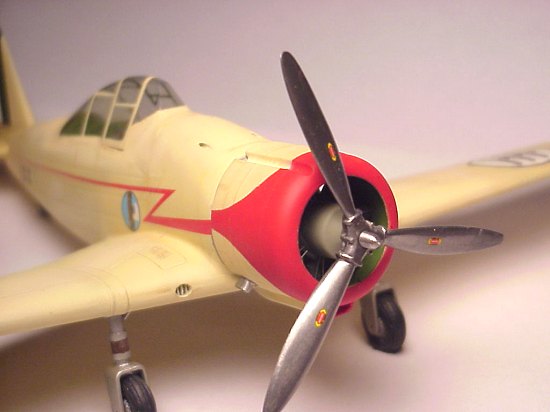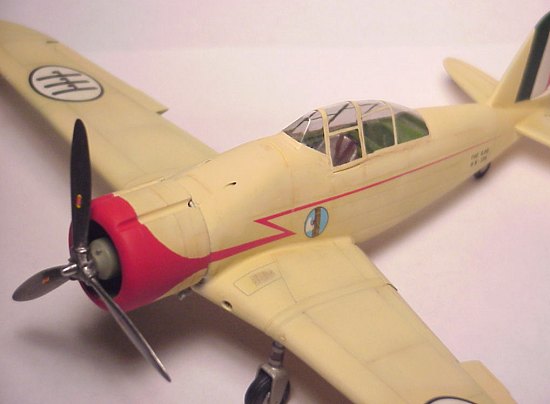
Tommy Atkins 1/48 Fiat G.50
|
KIT # |
? |
|
PRICE: |
? |
|
DECALS: |
See Review |
|
REVIEW : |
|
|
NOTES: |
Vacuformed kit. Conversion to prototype using Misterkit and EP Originals sets. |

|
HISTORY |
 The era of
biplanes was rapidly coming to an end, and caught off guard with nothing but
Cr.42's and Cr.32's left the Italian Air Force at a distinct disadvantage. The
Reggia Aeronautica was in sore need of a modern airplane fighter to fulfill
requirements into the next decade. With that in mind, the design work for the
G.50 was started as early as 1935. Of all metal construction, it proved
difficult to conform to a trend that was quickly becoming the norm in other
European countries. The Prototype differed in a few respects from the early
production models. One difference was the ailerons and flaps worked together to
provide high lift capabilities and allowed better longitudinal control. In the
event of production developments, some of these unique features were omitted to
simplify assemble and construction. Although the G.50 was essentially outdated
at the outset of Italy's entrance into the war, it was a popular and very nimble
airplane to fly.
The era of
biplanes was rapidly coming to an end, and caught off guard with nothing but
Cr.42's and Cr.32's left the Italian Air Force at a distinct disadvantage. The
Reggia Aeronautica was in sore need of a modern airplane fighter to fulfill
requirements into the next decade. With that in mind, the design work for the
G.50 was started as early as 1935. Of all metal construction, it proved
difficult to conform to a trend that was quickly becoming the norm in other
European countries. The Prototype differed in a few respects from the early
production models. One difference was the ailerons and flaps worked together to
provide high lift capabilities and allowed better longitudinal control. In the
event of production developments, some of these unique features were omitted to
simplify assemble and construction. Although the G.50 was essentially outdated
at the outset of Italy's entrance into the war, it was a popular and very nimble
airplane to fly.
|
THE KITS |
This is a conglomeration of three kits and update sets, two of which can only be bought from scalpers on websites such as E-bay. Having no basic G.50 kit available at the time I started this, a Vacuformed Atkins Fiat G.50 kit was used as the basic structure. Actually, only the fuselage was needed, and even only a few pieces of that was used. The E.P. Originals upgrade kit to backdate the Hasagawa kit was the second item I had as well as the superb G.50 wing from MisterKit to round off the parts. Granted the Vacuform kit would not had been the ideal kit to use, it saved me from trashing a perfectly good Sector/Hasagawa kit.
|
CONSTRUCTION |
 First off,
the interior was built up using interior photographs as a blueprint, scrap
plastic and metal pieces from the Atkins kit were used. The rudder and
tailplanes are from the E.P. Oringinal parts as well as the small upper decking
forward of the windscreen. Despite the differences between the Vac kit and the
Sector kit, the upgrade resin pieces fit pretty well.
First off,
the interior was built up using interior photographs as a blueprint, scrap
plastic and metal pieces from the Atkins kit were used. The rudder and
tailplanes are from the E.P. Oringinal parts as well as the small upper decking
forward of the windscreen. Despite the differences between the Vac kit and the
Sector kit, the upgrade resin pieces fit pretty well.
The E.P. parts had a brand new cowling for the prototype; it took a bit of work to fit the metal engine from the Vacuform kit into it, sanding the rocker arms and cylinder heads down. It took more fiddling to fix the completed power egg to the fuselage, not a lot of support there.
The MisterKit wing was a simple affair to attach. All the flying surfaces are molded separately, and detail was a great improvement over the original Vacuform wing. Since the first prototype had no landing gear covers, it simplified assemble that much more, and after what it took to get this far, that was a relief.
|
PAINT & DECALS |
 Possibly the
toughest part of this conversion is getting the proper paint finish and decals
information. Guessing from period photographs the overall color could have been
a cream off-white, or an overall silver dope. I chose the Cream color, along
with the fuselage pin stripe and MM numbers made on the trusty Alps printer. The
cowling is masked and painted, closely matching the red printed decal, thank
goodness.
Possibly the
toughest part of this conversion is getting the proper paint finish and decals
information. Guessing from period photographs the overall color could have been
a cream off-white, or an overall silver dope. I chose the Cream color, along
with the fuselage pin stripe and MM numbers made on the trusty Alps printer. The
cowling is masked and painted, closely matching the red printed decal, thank
goodness.
|
CONCLUSIONS |
Well, the whole kit probably cost me around $70.00, not bad for what it ended up looking like. Fun factor was 7 out of 10, but next time I'll wait to get that Sector G.50 kit. The finished project sure looks different than the usual camouflaged G.50. Thanks to Pacific Models for the MisterKit wing and the Ali D'Italia reference material.
Review kit courtesy of me and my wallet!
Copyright ModelingMadness.com. All rights reserved. No reproduction in part or in whole without express permission from the editor.
If you would like your product reviewed fairly and fairly quickly, pleasecontact the editor or see other details in the Note to Contributors.
Back to Reviews Page 2022